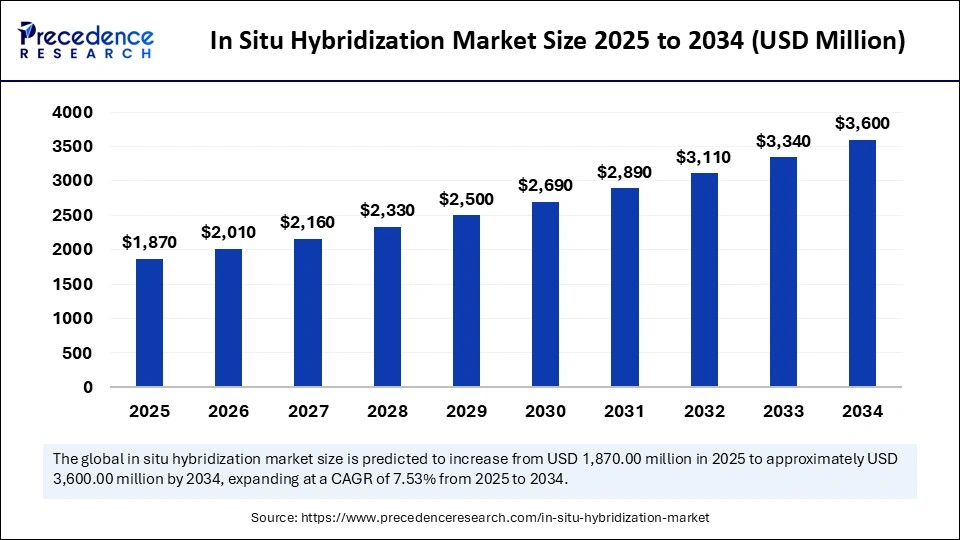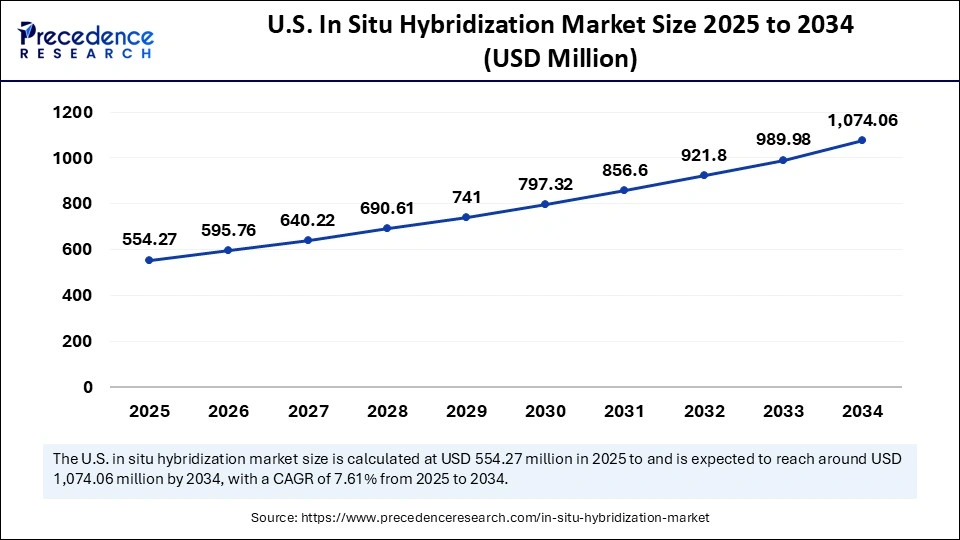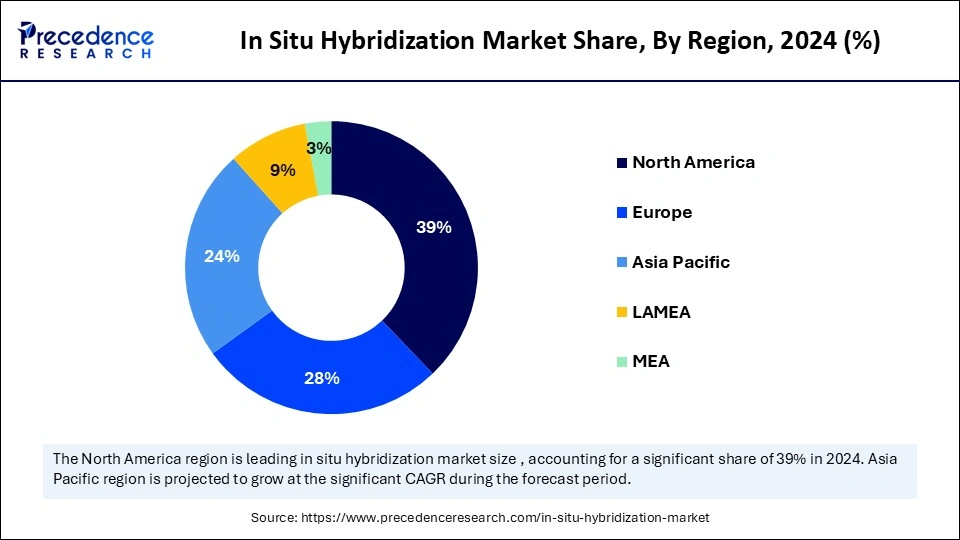List of Contents
What is the In-Situ Hybridization Market Size?
The global in-situ hybridization market size accounted for USD 1,870 million in 2025 and is predicted to increase from USD 2,010 million in 2026 to approximately USD 3,600 million by 2034, expanding at a CAGR of 7.53% from 2025 to 2034. This market is growing due to the rising prevalence of chronic diseases and advancements in technology, particularly in precision diagnostics and personalized medicine.

Market Highlights
- North America dominated the in-situ hybridization market, holding the largest market share of 39% in 2024.
- Asia Pacific is expected to grow at a notable CAGR of 30% from 2025 to 2034.
- By technology, the fluorescence in situ hybridization segment held the largest share of 54% in 2024.
- By technology, the chromogenic in situ hybridization segment is expected to expand at a 21% of CAGR from 2025 to 2034.
- By probe type, the DNA probes segment held the major market share of 59% in 2024.
- By probe type, the RNA probes segment is growing at a notable CAGR of 23% between 2025 and 2034.
- By application, the cancer diagnostics segment contributed the largest share 45% in 2024.
- By application, the neurology segment is poised to grow at a solid CAGR of 22% during the forecast period.
- By end-user, the hospitals & diagnostics laboratories segment is expected to grow at the fastest rate of 40% in the in situ hybridization market.
- By end-user, the research & academic institutions segment is accelerating a strong CAGR of 20% from 2025 to 20234.
Market Size and Forecast
- Market Size in 2025: USD 1,870 Million
- Market Size in 2026: USD 2,010 Million
- Forecasted Market Size by 2034: USD 3,600 Million
- CAGR (2025-2034): 7.53%
- Largest Market in 2024: North America
- Fastest Growing Market: Asia Pacific
What is the In-Situ Hybridization Market?
The in-situ hybridization market is experiencing rapid growth due to the increasing demand for accurate molecular diagnostics and research applications. It is frequently used in research on infectious diseases, genetic disorders, and cancer detection. Developments in automation and fluorescent ISH techniques are also fueling market adoption in clinical and research labs. Growing investments in biomarker research and personalized medicine also support long-term market expansion.
- In March 2025, BioTechne launched RNAscope ISH Protease Free Assays for the Roche Discovery ULTRA platform. The launch enhances RNA and protein biomarker development, providing researchers with more precise and efficient in situ hybridization tools.(Source: https://investors.bio-techne.com)
Key Technological Shifts in the In-Situ Hybridization Market
- Advanced Probe Designs: ISH methods are now more accurate and dependable thanks to recent advancements in probe technology. More thorough and reliable analysis of gene expression is now possible thanks to new RNA and DNA probes that can accurately identify even low-abundance genetic sequences.
- High-Sensitivity Methods: For the early detection of diseases like cancer or neurological disorders, new high-sensitivity ISH techniques are crucial because they can detect rare transcripts or single-copy genes. These techniques facilitate the identification of important biological changes as soon as possible.
- Automation and Digital Integration: Digital imaging systems and automation are simplifying ISH processes. Digital analysis tools allow for accurate visualization and measurement of hybridization signals, while automated platforms enhance consistency in sample processing. Clinical diagnostics and extensive research are accelerated and made more effective as a result.
In-Situ Hybridization Market Outlook
- Industry Growth Overview: FISH and CISH technological advancements are improving the precision and dependability of ISH methods. Adoption is being accelerated by the growing incidence of chronic illnesses and their incorporation into personalized medicine. Adoption of cutting-edge ISH solutions is being encouraged by the increased focus on precision diagnostics.
- Sustainability Trends: Market sustainability practices are being shaped by the development of energy-efficient imaging systems and environmentally friendly reagents. Environmentally friendly disposal techniques and waste reduction initiatives are being implemented in laboratories to promote sustainable practices. These programs complement international efforts to reduce the environmental impact of molecular diagnostics.
- Startup Ecosystem: To increase research capabilities, new businesses are launching cutting-edge ISH probes and imaging platforms. Product development is being accelerated through partnerships with reputable biotech companies and academic institutions. An increase in funding and investment is propelling the commercialization of advanced ISH technologies.
Market Scope
| Report Coverage | Details |
| Market Size in 2025 | USD 1,870 Million |
| Market Size in 2026 | USD 2,010 Million |
| Market Size by 2034 | USD 3,600 Million |
| Market Growth Rate from 2025 to 2034 | CAGR of 7.53% |
| Dominating Region | North America |
| Fastest Growing Region | Asia Pacific |
| Base Year | 2025 |
| Forecast Period | 2025 to 2034 |
| Segments Covered | Technology, Probe Type, Application, End-User, and Region |
| Regions Covered | North America, Europe, Asia-Pacific, Latin America, and Middle East & Africa |
Market Dynamics
Restraint
High Costs of Advanced Assays and Equipment
Significant investment is required for sophisticated technology platforms and fluorescent probes. Smaller labs or institutions in developing nations may find adoption challenging as a result. High-end imaging systems and multiplex assays also raise costs, which restricts access to these solutions, leading to obstacles in the in-situ hybridization market.
- In April 2025, Leica Biosystems and Bio-Techne launched the RNAscope Multiomic LS platform, an automated solution for spatial multiomics. While it streamlines workflows, the system requires considerable infrastructure investment.(Source: https://www.prnewswire.com)
Opportunity
Growing Adoption of Automated Platforms
Throughput is rising, reproducibility is being enhanced, and manual errors are being decreased in ISH workflows thanks to automation. Clinical labs and large-scale research projects can now more easily access ISH, thanks to automated systems that also support quicker and more accurate results. The efficiency of these platforms is further increased by their compatibility with digital pathology integration and high-throughput screening.
- In April 2025, Roche launched an automated ISH platform for clinical laboratories to streamline biomarker testing, reducing processing time while maintaining high accuracy.(Source: https://www.roche.com)
Segmental Insights
Technology Insights
What Made Fluorescence In Situ Hybridization (FISH) Segment Dominate the in In-Situ Hybridization Market in 2024?
Fluorescence in situ hybridization (FISH) dominated the in-situ hybridization market in 2024, with a 54% share, due to its high sensitivity, specificity, and ability to detect multiple genetic abnormalities simultaneously. Healthcare professionals and diagnostic labs favor FISH because of its widespread use in clinical diagnostics for detecting chromosomal abnormalities in cancer, prenatal testing, and genetic disorders.
The chromogenic in situ hybridization segment is expected to be the fastest-growing in the market during the forecast period, driven by the fact that chromogenic in situ hybridization is a rapidly growing technology due to its affordability and ease of integration with standard pathology workflows. Because CISH can be visualized under a typical bright-field microscope, it can be utilized in developing markets where access to sophisticated fluorescence equipment may be limited.
Probe Type Insights
Why Did DNA Probes Dominate the In-Situ Hybridization Market in 2024?
DNA probes dominated the in-situ hybridization market with a 59% share in 2024, largely due to their widespread use in detecting chromosomal abnormalities and genetic mutations. Their high specificity and dependability have made them market leaders. They serve as a fundamental component of molecular diagnostics, especially in the testing of genetic disorders and cancer.
The RNS probes segment is expected to be the fastest-growing in the market during the forecast period, driven by the growing need for precision medicine and RNA-based diagnostics. Research applications and new treatments in oncology, neurology, and infectious diseases are supported by RNA probes, which enable the detection of transcript variants, viral infections, and gene expression levels.
Application Insights
What Made the Cancer Diagnostics Segment Dominate the In-Situ Hybridization Market in 2024?
The cancer diagnostics segment dominated the in-situ hybridization market with a 45% share in 2024 due as cancer diagnostics are the market leader, driven by the vital role that in situ hybridization plays in detecting genetic mutations and biomarkers. Its adoption in hospitals and diagnostic labs around the world has been reinforced by its use in personalized medicine, prognosis, and therapy selection.
Neurology is expected to be the fastest-growing segment in the market during the forecast period, driven by growing research in neurological disorders. For both research and diagnostic purposes, ISH is being used more to examine gene expression patterns and biomarkers in neurological tissues.
End User Insights
What Made the Hospitals & Diagnostic Laboratories Segment Dominate the In-Situ Hybridization Market in 2024?
The hospitals & diagnostic laboratories segment dominated the in-situ hybridization market with a 40% share in 2024, driven by large-scale implementation of ISH techniques for clinical diagnostics. Hospitals and diagnostic laboratories dominate the market. Their advanced laboratory infrastructure, skilled personnel, and high patient volumes ensure consistent demand for ISH-based testing.
Research & academic institutions are expected to be the fastest-growing in the market during the forecast period, driven by a growing emphasis on molecular biology, genomics, and personalized medicine research. These organizations use ISH techniques for drug discovery, biomarker validation, and experimental research.
Regional Insights
U.S. In-Situ Hybridization Market Size and Growth 2025 to 2034
The U.S. in-situ hybridization market size was exhibited at USD 554.27 million in 2025 and is projected to be worth around USD 1,074.06 million by 2034, growing at a CAGR of 7.61% from 2025 to 2034.

What Made North America Dominate the In-Situ Hybridization Market?
North America dominated the market with a 39% share in 2024, driven by advanced healthcare infrastructure, strong R&D investments, and high adoption of cutting-edge technologies. North America dominates the market. The presence of established market players and ongoing clinical studies further drives demand for ISH in the region.
Canada In Situ Hybridization Market Trends
The Canada in situ hybridization market is growing steadily, supported by advanced healthcare infrastructure and rising demand for precision medicine, especially in oncology and rare diseases. Research institutions are increasingly using ISH for genomics studies, while government support and funding for biotech are promoting the adoption of automated ISH platforms.

The Asia Pacific dominated the market in 2024, driven by the expansion of healthcare infrastructure, increasing awareness of genetic disorders, and government support for advanced diagnostics. Asia Pacific is the fastest-growing regional market. Investments in biotechnology research are rising adoption of molecular diagnostics is fueling market growth.
India In Situ Hybridization Market
India in situ hybridization market is expanding rapidly due to growing expenditures on diagnostic research and healthcare infrastructure. Market expansion is being driven by the growing adoption of cutting-edge methods, such as FISH and RNA ISH, in research institutions, as well as increased awareness of precision medicine. The emergence of innovative biotech companies and supportive government initiatives further accelerates the adoption of automated ISH platforms.
Country-Level Investments / Funding Trends for In Situ Hybridization Market
| Country | Investment Context | Key Funding/Investment Trends |
| United States | Largest market with advanced infrastructure and high demand in oncology and genetics. | Strong adoption driven by increased healthcare spending, favorable regulatory approvals, and significant investment in precision medicine. |
| Germany | Leading market within Europe, supported by strong biotech R&D and high healthcare investment. | High R&D funding for cancer biomarker development and strong institutional support for genomics research. |
| India | A rapidly growing market within the Asia Pacific, with an improving healthcare infrastructure. | Increased healthcare investments and government support for genomics research are driving the adoption of advanced molecular diagnostics, such as ISH. |
| UAE | A growing hub in the Middle East, with a focus on local manufacturing and precision diagnostics. | Rising collaboration among key players and increasing investment in precision diagnostics, including ISH technologies. |
Top In-Situ Hybridization Market Companies
- Thermo Fisher Scientific (USA): Thermo Fisher is a global leader in scientific research and diagnostics, offering one of the broadest portfolios in genomics, proteomics, and analytical instrumentation.Its platforms like Ion Torrent™, Applied Biosystems™ PCR systems, and AmpliSeq™ are widely used in molecular testing, precision medicine, and next-generation sequencing (NGS).
- Agilent Technologies (USA): Agilent provides high-performance instruments and consumables for analytical chemistry, genomics, and diagnostics.The company's innovations in liquid chromatography, mass spectrometry, and genomics enable faster, data-driven insights in drug discovery and molecular diagnostics.
- Merck KGaA: Through its MilliporeSigma life science division, Merck delivers cutting-edge molecular biology reagents, CRISPR tools, and bioprocessing systems. Its integrated solutions support everything from early-stage gene editing to large-scale diagnostic and biopharma manufacturing.
- Roche: Roche Diagnostics leads globally in PCR-based and NGS molecular testing for oncology, infectious disease, and genetic disorders. Its cobas and AVENIO platforms are central to clinical diagnostics and companion diagnostics in precision healthcare.
- QIAGEN N.V.: QIAGEN specializes in sample preparation, nucleic acid isolation, and molecular diagnostics solutions for infectious diseases and oncology. Its QIAstat-Dx and QIAcube systems enable rapid, automated testing workflows for hospitals, research labs, and biotech companies.
Other Companies in the Market for In-Situ Hybridization
- PerkinElmer
- Bio-Rad Laboratories
- Bio-Techne Corporation
- Leica Biosystems
- Roche
- Abbott Laboratories
Recent Developments
- In October 2025, Yale University researchers developed a new technique that enhances the visualization of RNA activity within complex tissue structures, providing a clearer understanding of gene expression in situ.(Source: https://news.yale.edu)
- In February 2025, Molecular Instruments launched the HCR Gold and HCR Pro product lines to significantly expand the HCR Imaging Platform, enhancing in situ hybridization capabilities.(Source: https://www.businesswire.com)
Segments Covered in the Report
By Technology
- Fluorescence In Situ Hybridization (FISH)
- Chromogenic In Situ Hybridization (CISH)
- Dual-Color In Situ Hybridization
- RNA In Situ Hybridization
- DNA In Situ Hybridization
By Probe Type
- DNA Probes
- RNA Probes
- Chromosomal Probes
By Application
- Cancer Diagnostics
- Genetic Research
- Microbiology
- Neurology
- Others
By End-User
- Hospitals & Diagnostic Laboratories
- Research & Academic Institutions
- Pharmaceutical & Biotech Companies
By Region
- North America
- Europe
- Asia-Pacific
- Latin America
- Middle East & Africa
For inquiries regarding discounts, bulk purchases, or customization requests, please contact us at sales@precedenceresearch.com
Frequently Asked Questions
Ask For Sample
No cookie-cutter, only authentic analysis – take the 1st step to become a Precedence Research client